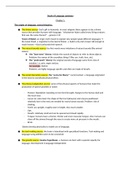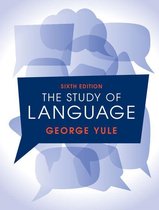Study of Language summary
Chapter 1.
The origins of language, several theories:
● The divine source: God’s gift to humanity. In most religions there appears to be a divine
source that provides humans with language. ‘’whatsoever Adam called every living creature,
that was the name thereof’’ – genesis 2:19.
Tower of Babel: an origin myth meant to explain why people speak different languages →
the Great Flood → migration to the land of Shinar → build a city and a tower tall enough to
reach heaven →God confounds their speech.
● The natural sounds source: the first words were imitations of natural sounds (like animal
noises)
❖ the ‘’bow-wow’’ theory: Imitate the sounds of objects to refer to those objects.
Problem: the names of the soundless things? (like sun, truth, love, etc).
❖ The ‘’pooh-pooh’’ theory: the original sounds of language came from cries of
emotion, i.e. pain, anger and joy.
For example: OUCH!.
Problem: are highly language specific and often on intake of breath.
● The social interaction source: the ‘’yo-he-ho theory’’: social context → language originated
in the need to coordinate physical effort.
● The physical adaptation source: some of the physical aspects of humans that make the
production of speech possible or easier:
- Posture: bipedalism (standing on two feet) brought changes to the human skull and
the vocal tract.
- Larynx (or voice box): the shape of the tract (pharynx) and a larynx positioned
relatively low in the neck are needed for many human sounds. Problem: risk of
choking.
- Teeth: are upright, roughly even in height. Also much smaller.
- Lips.
- Mouth: relatively small and can be opened and closed rapidly.
- Tongue: humans have a shorter, thicker and more muscular tongue. Also, humans can
close off the airway through the nose to create more air pressure in the mouth.
- Brain.
Babies develop physically to enable use of language.
● the tool-making source: the brain is lateralized with specialized functions. Tool-making and
language-using abilities seem to be connected.
● The genetic source: innates hypotheses → humans are born with a special capacity for
language. Development is language independent.
, Chapter 5.
Etymology: the study of the origin and the history of a word. Greek and Latin are the sources of
many English words.
Neologism: a new word or expression, or a new meaning of an existing word.
Different processes:
● Acronyms: new words formed from the initial letters of a set of other words.
Examples: CD (compact disk), NATO, NASA, laser, radar, scuba, a sim, card and zip code, snafu, ATM
& PIN.
● Clipping: when a word of more than one syllable is reduced to a shorter form, usually
beginning in casual speech.
Examples: gas instead of gasoline, bra instead of brassiere, cab instead of cabriolet,, fan instead of
fanatic, perm instead of permanent wave, phone, plane, porn and pub (public house), exam,
and vape.
● Backformation: a word of one type (usually a noun) is reduced to form a word of another
type (usually a verb).
Examples: television-televise, donate-donation, emote-emotion, opt-option, etc
● Hypocorism: a longer word is reduced to a single syllable, then -y or -ie is added to the end.
Examples: movie (moving pictures), Aussie (Australian), barbie (barbecue), bickie (biscuit), bookie
(bookmaker), brekky (breakfast), hankie (handkerchief), toastie (toasted sandwich).
● Derivation: the origin of a word, from which another form has developed, or the new form
itself.
Examples: words with prefixes, suffixes and infixes.
● Coinage: the invention and general use of totally new terms.
Examples: aspirin, nylon, Vaseline, zipper, granola, Kleenex, Teflon, xerox and google.
● Borrowing: the taking over of words from other languages.
Examples: dope (Dutch), jewel (French), glitzy (Yiddish), lilac (Persian), piano (Italian), ski
(Norwegian), sofa (Arabic), tattoo (Tahitian), Tycoon (Japanese), yogurt (Turkish), zebra
(Bantu).
● Compounding: a joining of two separate words to produce a single form.
Examples: bookcase, sunburn, wallpaper and wastebasket.
, ● Blending: the combination of two separate forms to produce a single new term. In blending
we typically take only the beginning of one word and join it to the end of the other word.
Examples: smog. smoke + haze = smaze, smoke + murk = smurk. Binary + digit = bit. Web + log = blog.
● Eponyms: new words based on the name of a person or a place.
Examples: hoover, spangler, teddy bear (from Theodore Roosevelt), jeans and sandwich.
● Conversion: a change in the function of a word, as for example when a noun comes to be
used as a verb (without any reduction!). also known as category change or functional shift.
Noun Verb
Dust Did you dust the living room?
Glue I’ll have to glue it together
Referee Who will referee the game?
Water Would you water my plants?
● Claque (loan translation): a special type of borrowing. In this process, there is a direct
translation of the elements of a word into the borrowing language.
The term deli is first borrowing from German word delicatessen, then borrowed form is clipped.
Analogy: new words are formed that are similar in some way to existing words.
For example: yuppie (earlier word hippie and another short-lived analogy yippie).
Chapter 6.
Morphology: the study of forms/used to describe the study of all the basic ‘’elements’’ used in a
language.
A morpheme: a minimal unit of meaning or grammatical function.
Morphemes Or grammatical function
Re- (‘’again’’) new (‘’recently made’’) -ed (past tense)
Tour (‘’travel for pleasure’’) -ist (‘’person who’’) -s (plural)
Free morphemes: morphemes that can stand by themselves as single words. Nouns, verbs,
adjectives & adverbs
Bound morphemes: morphemes that cannot normally stand alone.
Undressed Carelessness






